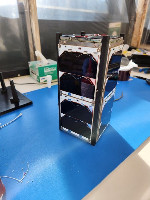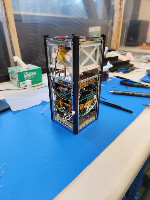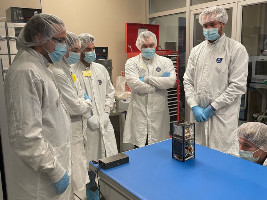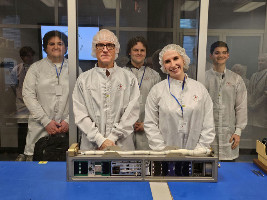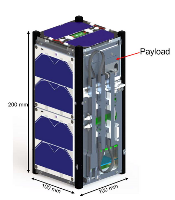| Satellite name | QMSat (Quantum Magneto Satellite, UdeSat) |
|---|---|
| Form factor | CubeSat |
| Units or mass | 2U |
| Status | Reentry 2024-08-01. No signal? (Inconclusive news and SatNOGS reports as of May 2024) |
| Launched | 2024-03-21 |
| NORAD ID | 59560 ? |
| Deployer | NRCSD (NanoRacks CubeSat Deployer) [Quad-M] |
| Launcher | Falcon 9 (CRS-30) |
| Deployment | Deployed from ISS on 2024-04-18 |
| Organisation | Université de Sherbrooke |
| Institution | University |
| Entity type | Academic / Education |
| Headquarters | Canada |
| Partners | École Nationale d'Aérotechnique, MDA |
| Oneliner |
In-orbit demonstration of a quantum magnetometer. |
| Description |
In-orbit demonstration of a quantum magnetometer. The operation of the magnetometer depends largely on the material properties of the diamond resulting from the structure of the carbon atoms that compose it. With many of these satellites, it would be possible to map the Earth's magnetic field. Thus, the analysis of the data collected will make it possible to predict the location of a future lightning bolt, earthquakes, solar flares and even find a submarine sunk in the open sea. Quantum magnetometer, based on a nitrogen-vacancy diamond, would allow 3d vectorial measurements of the earth’s magnetic field with a resolution that is estimated to be 2 orders of magnitude better than traditional, 1-axis magnetometer. The success of the mission resides in acquiring meaningful samples of the magnetic field using the quantum magnetometer with a resolution close to the earthbound prototype, successful transmission of these samples back to earth and displaying the data on an earth’s map on the QMSat website. Therefore, the QMSat mission can be defined in several parts: the payload, the satellite (designed to acquire, process and send samples for an estimated lifespan of more than a year), the communication between the terrestrial base and the latter as well as social efforts. Conduct one of the first demonstrations of a quantum sensor in space. Quantum sensors use the unique and often strange behaviour of matter at very small distances to perform ultra-sensitive and robust measurements. This quantum sensor uses nitrogen-vacancy defects in a tiny piece of diamond to measure the intensity and orientation of the magnetic field in space. Such measurements are useful to study the effect of solar storms on radio communication, GPS or electrical grids, or the flow of magma under Earth’s crust, for instance. Quantum technologies, such as this magnetometer, will lead to smaller, more energy efficient, and more sensitive sensors for space applications. Sirius is a student project from the University of Sherbrooke whose mission is to design a CubeSat. |
| Notes |
One of 15 winners of Canadian CubeSat Project. Announced resignation of its place in the Canadian CubeSat Project but plan to continue development. |
| Sources | [1] [2] [3] [4] [5] [6] [7] [8] [9] |
| Photo sources | [1] [2] [3] |
| Keywords | Deployable boom |
Last modified: 2024-12-15
